Who is the Man in the Iron Mask?
Died in 1703, he would have lived the last 34 years of his life in prison, including 11 at the Fort of Île Sainte-Marguerite in Cannes. He is the most famous prisoner in the world, and the mystery of his identity has never ceased to fuel the imaginations, including that of Voltaire: “We were ordered to kill him if he uncovered the mask with which the chin bar had been worn. steel springs which gave him the freedom to eat with the mask on his face”. Since the 17th century, he has been credited with more than fifty identities such as the twin brother of Louis XIV, his illegitimate son Louis de Bourbon or the superintendent Nicolas Fouquet.










